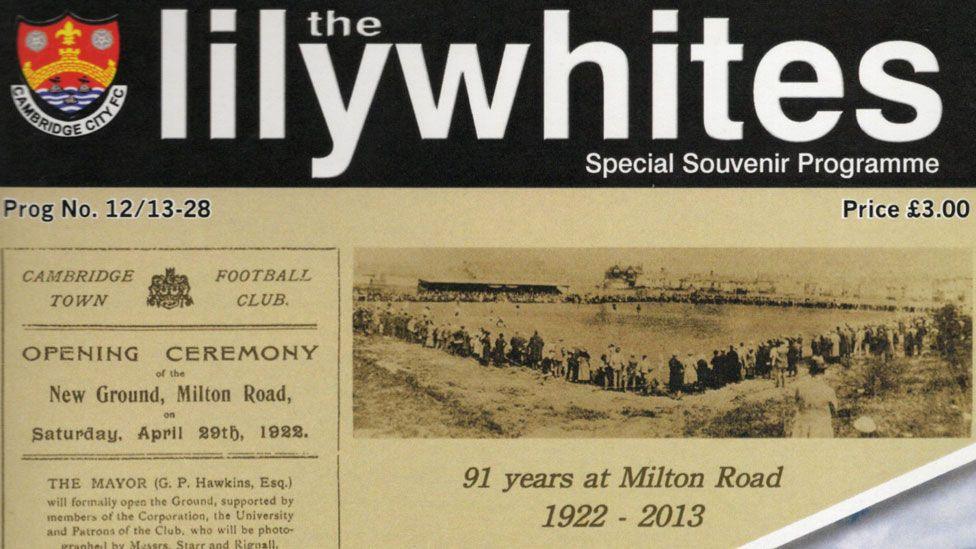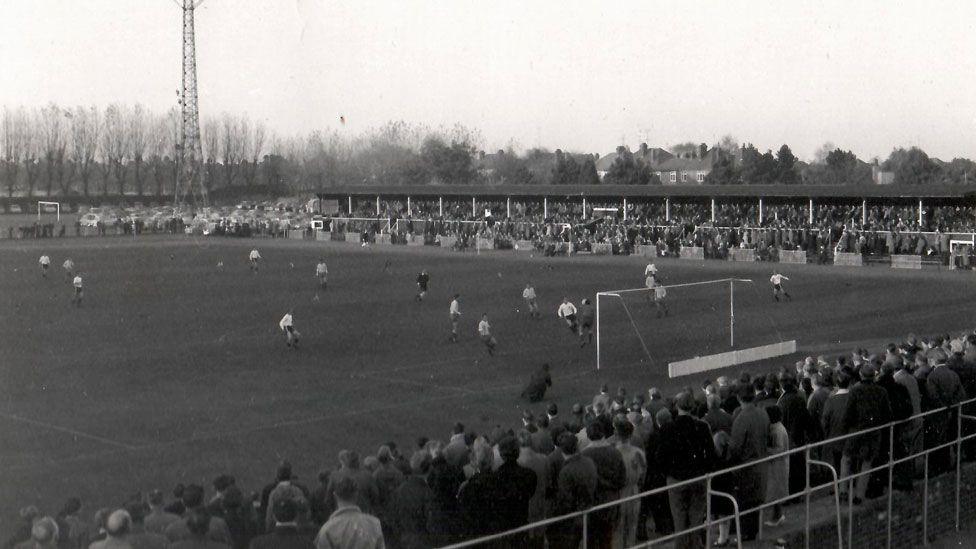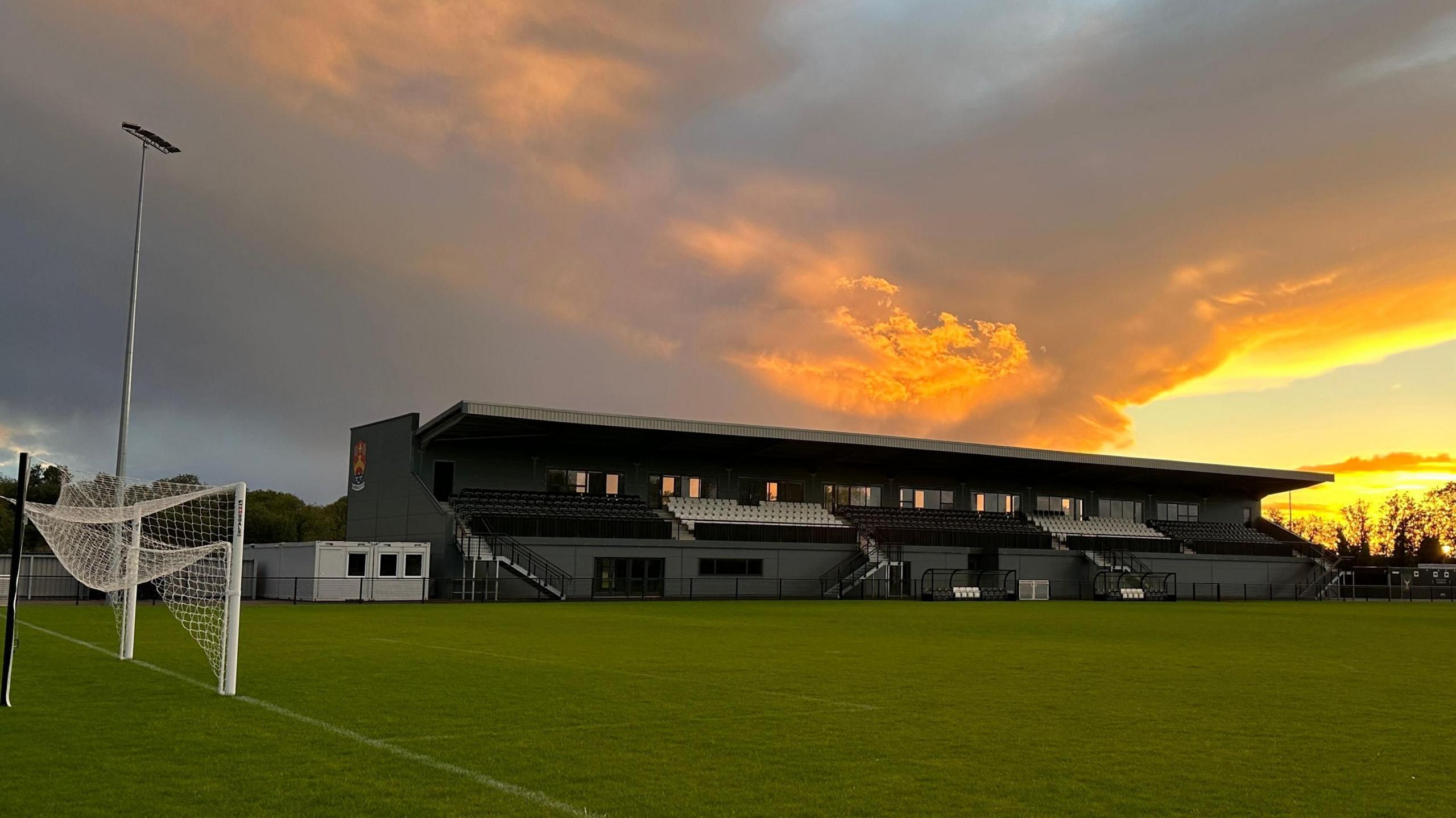How a 116-year-old club forged a path to a new home

Cambridge City FC will play their first game at the new FWD/IP Community Stadium on Saturday
- Published
A 116-year-old city football club is preparing for a new chapter in its history with its first fixture at a brand new stadium.
Cambridge City FC will play their first game at the new FWD/IP Community Stadium in the nearby village of Sawston on Saturday, after sharing a ground with both St Ives and Histon since 2012-13.
Club historian and former player, Neil Harvey, 60, first began delving into the Isthmian League team's highs and lows after he started following City on leaving school aged 18.
"Officially, it's our 24th venue since the club was set up in 1908," he said, although the high number of bases was mostly due to it playing at many different venues before World War One.

Cambridge Town FC - as it was then known - with the International du Nord Trophy, won in Tourcoing, Lille, France, in 1912, when their players were amateur townsfolk
"It's like, wow, is this really our football club?" said Mr Harvey about the new stadium as it prepares to be ready for the visit of Tilbury in the Isthmian's Northern Division, which is in tier eight of the English football league pyramid.

The club traditionally played in white shirts, earning the team its nickname The Lilywhites, and it moved to Milton Road in 1922
"It was the nearest club to where I grew up on the north side of Cambridge and in the early 1980s I was working in Shire Hall with a former player called Brian Holmes, who played for the club in the 1950s," he said.
As well as delving into archives, he was regularly attending matches, even getting the chance to play for his team.
"I'd gone to watch the reserves one Saturday afternoon, and not long before kick-off I was asked if I had my kit with me as one of the subs hadn't turned up," Mr Harvey said.
"I joined the bench for the match and with 15 minutes to go, playing Harlow Town reserves at Milton Road, I came on and made my first appearance."

Neil Harvey still occasionally plays for the Lillywhites' Legends teams, saying: "I'm not sure if I really qualify as a 'Legend', but when offered the chance to play I wasn't going to turn it down"

The big change for The Lilywhites came in 1958 when the club turned professional and so instead of local players, it began recruiting from all over the country
The club was set up by a group of Edwardian, middle-class residents who dubbed it Cambridge Town - the university town was not granted city status until 1951.
After World War One, it found a permanent home at Milton Road where it stayed for 91 years.
Mr Harvey said it was proudly amateur in the inter-war period, developing a fierce rivalry with Ipswich Town FC, but declining to go professional with the Suffolk club in 1936, external.

As a result, it was regularly attracted thousands of fans to its matches in the 1960s, such as this one in November 1965 (Cambridge City v Weymouth)
The club won the Spartan League competition three times between the end of World War Two and 1950 and successfully applied to change its name to Cambridge City, ahead of rival Abbey United, which changed names to Cambridge United.
More glory came from the late 1950s, becoming Southern League champions in 1962-63 and staying top of the division until 1968, when it was relegated.
Mr Harvey, who works for an education consultancy and now lives in Girton, said: "City had the highest attendances of non-league football, regularly attracting gates of 3,500 fans, beating United - sometimes even attracting 10,000 packed into our tiny Milton Road ground."

Mr Harvey hopes the Sawston ground move will spur his team on to success, mirroring what happened when the club moved to a new Milton Road pitch in the 1980s
City played on the original pitch until 1984 when it moved to the next-door site.
It left Milton Road in 2013, signing off with a 1-0 win over Redditch, after the land was sold for housing, and fans are ready to put a decade without a home of their own behind them.
Mr Harvey said: "There's certainly masses of interest in this first game and I wouldn't be surprised if we pushed 1,000 fans on Saturday.
"I think the team will push on, we can hopefully get into play-offs this season - and who knows after that?"

The new ground is very much a community effort for its fans, with Mr Harvey doing turns cleaning its changing rooms
Get in touch
Do you have a story suggestion for Cambridgeshire?
Follow Cambridgeshire news on BBC Sounds, Facebook, external, Instagram, external and X, external.
- Published20 November 2024

- Published5 March 2021

- Published2 March 2018
